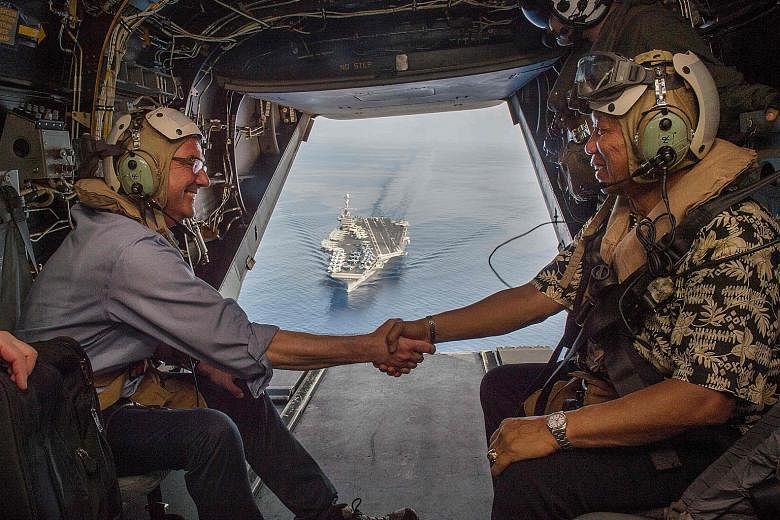ABOARD THE USS JOHN C. STENNIS (In the South China Sea) • Over the last week in Asia, US Defence Secretary Ashton Carter has visited two aircraft carriers, revealed new military agreements with India and the Philippines, and generally signalled that the Obama administration has decided to lean more heavily on military power to counter China's territorial ambitions in the region.
But the new, muscular approach on display during Mr Carter's tour represents a gamble. While it sends a message that the United States will work with its allies to challenge Beijing's expanding presence in the disputed South China Sea, it also plays into fears within the Chinese leadership about US efforts to halt China's rise.
That may mean that the more the Pentagon steps up in the region, the more China may feel it needs to accelerate its military build-up, including the construction of new islands equipped with radar and airstrips in contested waters.
With a mix of showmanship and concrete initiatives during a six-day visit to India and the Philippines, Mr Carter left little doubt that the US intends both to strengthen alliances and move more hardware and troops here to counter China's growing military reach.
On Friday, he rode a helicopter to a symbol of American power projection in the Pacific, a Nimitz-class nuclear-powered aircraft carrier, as it cruised through the South China Sea near waters claimed by the Chinese.

Before visiting the carrier John C. Stennis, he marked the end of 11 days of military exercises between the US and the Philippines and said some US troops would stay behind "to contribute to regional security and stability".
He also said the US had begun joint patrols of the South China Sea with the Philippine navy and would soon do the same with the country's air force.
Earlier in the week, Mr Carter toured an Indian aircraft carrier, the first time a US defence secretary had boarded such a ship, and said the US would help India upgrade its carriers.
He also revealed a new logistics agreement and said the two nations would work together on other military technologies.
Together, the measures announced by Mr Carter hint at a potential US military resurgence in a part of the world where China believes it is destined to surpass the US in influence.
The Obama administration seems to be betting that China will back off rather than continue making moves that lead its neighbours to embrace the US military.
But some analysts warn that China could react to the Pentagon's moves by taking more aggressive action, challenging America's commitment to the region in a high-profile game of chicken and raising the risk of a military conflict.
The Chinese have been closely watching Mr Carter's tour, which had included a stop in Beijing before it was abruptly scrubbed from the schedule a few weeks ago. In a late-night statement on Thursday, the Chinese Defence Ministry accused the US of reverting to a "Cold War mentality" and said the Chinese military would "pay close attention to the situation and resolutely defend China's territorial sovereignty and maritime interests".
On Friday, China also disclosed that its most senior uniformed military commander had visited the disputed Spratly Islands, which appeared intended to signal Beijing's resolve in the South China Sea, most of which it considers Chinese territory.
Dr Su Hao, a professor of international relations at China Foreign Affairs University in Beijing, said: "China sees its actions in the South China Sea as legitimate in protecting its own sovereignty and integrity. China will not just change its behaviours or deployment plan simply because of the Americans." NEW YORK TIMES

